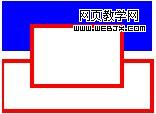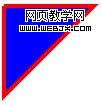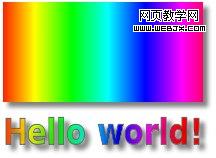本篇内容主要讲解“HTML5 canvas的基本语法介绍”,感兴趣的朋友不妨来看看。本文介绍的方法操作简单快捷,实用性强。下面就让小编来带大家学习“HTML5 canvas的基本语法介绍”吧!
创建 canvas 的方法很简单,只需要在 HTML 页面中添加 <canvas> 元素:
<canvas id="myCanvas" width="300" height="150"> Fallback content, in case the browser does not support Canvas. </canvas>
为了能在 JavaScript 中引用元素,最好给元素设置 ID ;也需要给 canvas 设定高度和宽度。
创建好了画布后,让我们来准备画笔。要在画布中绘制图形需要使用 JavaScript 。首先通过 getElementById 函数找到 canvas
元素,然后初始化上下文。之后可以使用上下文 API 绘制各种图形。下面的脚本在 canvas 中绘制一个矩形 (点击此处查看效果):
// Get a reference to the element.
var elem = document.getElementById('myCanvas');
// Always check for properties 和 methods, to make sure your code doesn't break
// in other browsers.
if (elem && elem.getContext) {
// Get the 2d context.
// Remember: you can only initialize one context per element.
var context = elem.getContext('2d');
if (context) {
// You are done! Now you can draw your first rectangle.
// You only need to provide the (x,y) coordinates, followed by the width and
// height dimensions.
context.fillRect(0, 0, 150, 100);
}
}可以把上面代码放置在文档 head 部分中,或者放在外部文件中。
介绍了如何创建 canvas 后,让我们来看看 2D canvas API,看看能用这些函数做些什么。
上面的例子中展示了绘制矩形是多么简单。
通过fillStyle和strokeStyle属性可以轻松的设置矩形的填充和线条。颜色值使用方法和 十六进制数、()、() 和 ()( 若浏览器支持,如 Opera10 和 Firefox 3)。十六进制数、()、() 和 ()( 若浏览器支持,如 Opera10 和 Firefox 3)。
通过 fillRect 可以绘制带填充的矩形。使用 strokeRect 可以绘制只有边框没有填充的矩形。如果想清除部分 canvas 可以使用 clearRect。上述三个方法的参数相同:x,y,width,height。前两个参数设定 (x,y) 坐标,后两个参数设置矩形的高度和宽度。
可以使用lineWidth属性改变线条粗细。让我们看看使用了fillRect,strokeRect clearRect 和其他的例子:
context.fillStyle = '#00f'; // blue context.strokeStyle = '#f00'; // red context.lineWidth = 4; // Draw some rectangles. context.fillRect (0, 0, 150, 50); context.strokeRect(0, 60, 150, 50); context.clearRect (30, 25, 90, 60); context.strokeRect(30, 25, 90, 60);
此例子效果图见图1.

图 1: fillRect, strokeRect 和
clearRect效果图
通过 canvas 路径(path)可以绘制任意形状。可以先绘制轮廓,然后绘制边框和填充。创建自定义形状很简单,使用 beginPath()开始绘制,然后使用直线、曲线和其他图形绘制你的图形。绘制完毕后调用 fill 和 stroke 即可添加填充或者设置边框。调用 closePath() 结束自定义图形绘制。
下面是一个绘制三角形的例子:
// Set the style properties. context.fillStyle = '#00f'; context.strokeStyle = '#f00'; context.lineWidth = 4; context.beginPath(); // Start from the top-left point. context.moveTo(10, 10); // give the (x,y) coordinates context.lineTo(100, 10); context.lineTo(10, 100); context.lineTo(10, 10); // Done! Now fill the shape, 和 draw the stroke. // Note: your shape will not be visible until you call any of the two methods. context.fill(); context.stroke(); context.closePath();
其效果图见图2.

图 2: 三角形
另一个较负责的例子中使用了直线、曲线和圆弧。
drawImage 方法允许在 canvas 中插入其他图像
( img 和 canvas 元素) 。在 Opera 中可以再 canvas 中绘制 SVG 图形。此方法比较复杂,可以有3个、5个或9个参数:
3个参数:最基本的 drawImage 使用方法。一个参数指定图像位置,另两个参数设置图像在 canvas中的位置。
5个参数:中级的 drawImage 使用方法,包括上面所述3个参数,加两个参数指明插入图像宽度和高度 (如果你想改变图像大小)。
9个参数:最复杂 drawImage 杂使用方法,包含上述5个参数外,另外4个参数设置源图像中的位置和高度宽度。这些参数允许你在显示图像前动态裁剪源图像。
下面是上述三个使用方法的例子:
// Three arguments: the element, destination (x,y) coordinates. context.drawImage(img_elem,dx,dy); // Five arguments: the element, destination (x,y) coordinates, and destination // width and height (if you want to resize the source image). context.drawImage(img_elem,dx,dy,dw,dh); // Nine arguments: the element, source (x,y) coordinates, source width and // height (for cropping), destination (x,y) coordinates, and destination width // and height (resize). context.drawImage(img_elem,sx,sy,sw,sh,dx,dy,dw,dh);
其效果见图3.

图 3: drawImage 效果图。
2D Context API 提供了三个方法用于像素级操作:createImageData, getImageData, 和putImageData。
ImageData对象保存了图像像素值。每个对象有三个属性:width,height和
data。data属性类型为CanvasPixelArray,用于储存width*height*4个像素值。每一个像素有RGB值和透明度alpha值(其值为 0 至
255,包括alpha在内!)。像素的顺序从左至右,从上到下,按行存储。
为了更好的理解其原理,让我们来看一个例子——绘制红色矩形
// Create an ImageData object.
var imgd = context.createImageData(50,50);
var pix = imgd.data;
// Loop over each pixel 和 set a transparent red.
for (var i = 0; n = pix.length, i < n; i += 4) {
pix[i ] = 255; // red channel
pix[i+3] = 127; // alpha channel
}
// Draw the ImageData object at the given (x,y) coordinates.
context.putImageData(imgd, 0,0);注意: 不是所有浏览器都实现了 createImageData。在支持的浏览器中,需要通过 getImageData 方法获取 ImageData 对象。请参考示例代码。
通过 ImageData 可以完成很多功能。如可以实现图像滤镜,或可以实现数学可视化 (如分形和其他特效)。下面特效实现了简单的颜色反转滤镜:
// Get the CanvasPixelArray from the given coordinates and dimensions.
var imgd = context.getImageData(x,y,width,height);
var pix = imgd.data;
// Loop over each pixel and invert the color.
for (var i = 0, n = pix.length; i < n; i += 4) {
pix[i ] = 255 - pix[i ]; // red
pix[i+1] = 255 - pix[i+1]; // green
pix[i+2] = 255 - pix[i+2]; // blue
// i+3 is alpha (the fourth element)
}
// Draw the ImageData at the given (x,y) coordinates.
context.putImageData(imgd,x,y);图 4 显示了使用此滤镜后的 Opera
图像 (图 3是原图)。

图 4: 颜色反转滤镜
虽然最近的 WebKit 版本和 Firefox 3.1 nightly build 才开始支持 Text API ,为了保证文章完整性我决定仍在这里介绍文字 API 。
context 对象可以设置以下 text 属性:
font:文字字体,同属性属性
textAlign:文字水平对齐方式。可取属性值: start, end, left,right, center。默认值:start.
textBaseline:文字竖直对齐方式。可取属性值:top, hanging, middle,alphabetic, ideographic, bottom。默认值:alphabetic.
有两个方法可以绘制文字: fillText 和 strokeText。第一个绘制带fillStyle填充的文字,后者绘制只有strokeStyle边框的文字。两者的参数相同:要绘制的文字和文字的位置(x,y) 坐标。还有一个可选选项——最大宽度。如果需要的话,浏览器会缩减文字以让它适应指定宽度。
文字对齐属性影响文字与设置的
(x,y) 坐标的相对位置。
下面是一个在 canvas 中绘制"hello world" 文字的例子
context.fillStyle = '#00f';
context.font = 'italic 30px sans-serif';
context.textBaseline = 'top';
context.fillText ('Hello world!', 0, 0);
context.font = 'bold 30px sans-serif';
context.strokeText('Hello world!', 0, 50);图 5 是其效果图。

图 5: 文字效果
目前只有 Konqueror 和 Firefox 3.1 nightly build 支持 Shadows API 。API 的属性为:
shadowColor:阴影颜色。其值和 CSS 颜色值一致。
shadowBlur:设置阴影模糊程度。此值越大,阴影越模糊。其效果和 Photoshop 的高斯模糊滤镜相同。
shadowOffsetX 和 shadowOffsetY:阴影的 x 和 y 偏移量,单位是像素。
下面是 canvas 阴影的例子:
context.shadowOffsetX = 5; context.shadowOffsetY = 5; context.shadowBlur = 4; context.shadowColor = 'rgba(255, 0, 0, 0.5)'; context.fillStyle = '#00f'; context.fillRect(20, 20, 150, 100);
其效果见图 6。

图 6: canvas 阴影效果——蓝色矩形,红色阴影
除了 CSS 颜色, fillStyle 和 strokeStyle 属性可以设置为 CanvasGradient 对象。——通过 CanvasGradient可以为线条和填充使用颜色渐变。
欲创建 CanvasGradient 对象,可以使用两个方法:createLinearGradient 和 createRadialGradient。前者创建线性颜色渐变,后者创建圆形颜色渐变。
创建颜色渐变对象后,可以使用对象的 addColorStop 方法添加颜色中间值。
下面的代码演示了颜色渐变使用方法:
// You need to provide the source 和 destination (x,y) coordinates // for the gradient (from where it starts 和 where it ends). var gradient1 = context.createLinearGradient(sx,sy,dx,dy); // Now you can add colors in your gradient. // The first argument tells the position for the color in your gradient. The // accepted value range is from 0 (gradient start) to 1 (gradient end). // The second argument tells the color you want, using the CSS color format. gradient1.addColorStop(0, '#f00'); // red gradient1.addColorStop(0.5, '#ff0'); // yellow gradient1.addColorStop(1, '#00f'); // blue // For the radial gradient you also need to provide source // 和 destination circle radius. // The (x,y) coordinates define the circle center points (start 和 // destination). var gradient2 = context.createRadialGradient(sx,sy,sr,dx,dy,dr); // Adding colors to a radial gradient is the same as adding colors to linear // gradients.
我也准备了一个更复杂的例子,使用了线性颜色渐变、阴影和文字。其效果见图 7。

图 7: 使用线性颜色渐变的例子
到此,相信大家对“HTML5 canvas的基本语法介绍”有了更深的了解,不妨来实际操作一番吧!这里是亿速云网站,更多相关内容可以进入相关频道进行查询,关注我们,继续学习!
免责声明:本站发布的内容(图片、视频和文字)以原创、转载和分享为主,文章观点不代表本网站立场,如果涉及侵权请联系站长邮箱:is@yisu.com进行举报,并提供相关证据,一经查实,将立刻删除涉嫌侵权内容。